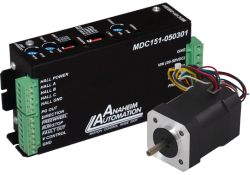We use cookies to make your experience better. To comply with the new e-Privacy directive, we need to ask for your consent to set the cookies. Learn more.
Top 5 BLDC Motor and Controller Failures: A Practical Troubleshooting Guide
Top 5 BLDC Motor and Controller Failures: A Practical Troubleshooting Guide
Brushless DC (BLDC) motors are widely used across industries for their high efficiency, long service life, and reliable performance. They eliminate the need for brushes and commutators by using electronic commutation, which reduces wear and improves precision. Despite these advantages, BLDC motors and BLDC controllers can experience operational issues due to mechanical, electrical, or environmental factors.
This article outlines common problems encountered in BLDC systems and provides practical troubleshooting methods for engineers and technicians.


1. Motor Fails to Start or Runs Erratically
Symptoms:
- Motor fails to start
- Inconsistent or jerky rotation
- Unexpected stops or startup hesitation
Possible Causes:
- Power Supply Issues: Insufficient or unstable voltage can prevent proper motor operation.
- Controller or Driver Malfunction: A faulty controller may fail to provide the necessary signals.
- Motor Winding Faults: Open or shorted windings disrupt electromagnetic torque generation.
- Hall Sensor Failure: Defective sensors provide incorrect rotor position feedback.
- Incorrect Wiring: Miswiring between the motor, controller, and power source.
Recommended Actions:
- Measure power supply voltage and confirm it meets the motor/controller specifications.
- Inspect controller outputs using an oscilloscope or multimeter.
- Use a continuity test to check for open or shorted motor windings.
- Manually rotate the motor shaft and observe Hall sensor output transitions.
- Verify all electrical connections against the wiring diagram.
2. Overheating During Operation
Symptoms:
- Motor or controller becomes excessively hot
- Thermal shutdowns or degraded performance
Possible Causes:
- Overloading: The motor operates under load conditions beyond its rated specifications.
- Inadequate Cooling: Insufficient airflow or lack of heat sinks/fans.
- Faulty Bearings: Worn bearings increase mechanical resistance.
- Excessive Drive Current: Drive settings allow current beyond motor ratings.
Recommended Actions:
- Reduce the mechanical load or duty cycle.
- Ensure proper ventilation around the motor and controller.
- Inspect and lubricate or replace bearings if needed.
- Adjust the drive current settings to align with the motor’s rated current.
3. Excessive Noise or Vibration
Symptoms:
- Unusual acoustic noise
- Noticeable vibration or shaking during operation
Possible Causes:
- Rotor Imbalance: Uneven mass distribution causes unbalanced rotation.
- Bearing Wear or Damage: Defective bearings produce friction and noise.
- Loose Mechanical Components: Vibrations caused by insecure mountings or couplings.
- Misalignment: Improper alignment with shafts or gearboxes.
- Foreign Debris: Particles inside the housing interfere with movement.
- Gear Malfunction: Incorrect gear meshing or worn gear teeth.
Recommended Actions:
- Balance the rotor and any attached load.
- Replace noisy or worn bearings.
- Tighten all motor mounts, fasteners, and couplings.
- Re-align motor shafts and driven components.
- Inspect and clean the motor interior.
- Check gearboxes for proper mesh and lubricate or replace worn components.
4. Controller Malfunction or Unresponsive Behavior
Symptoms:
- Controller fails to operate or responds inconsistently
- System enters fault or protection mode unexpectedly
- Irregular or unstable motor output
Possible Causes:
- Overcurrent or Short Circuit: Triggering built-in protection mechanisms.
- Overheating of Control Electronics: Caused by inadequate heat management.
- Electronic Component Failure: Damaged resistors, capacitors, or ICs.
- Software/Firmware Errors: Corrupted firmware or programming bugs.
Recommended Actions:
- Inspect for electrical shorts or excessive load conditions.
- Monitor controller temperature and ensure proper cooling or heat sinking.
- Visually inspect PCB components for signs of thermal or physical damage.
- Reinstall or update firmware using the manufacturer’s toolset.
5. Hall Sensor Malfunctions
Symptoms:
- Motor stalls, runs unevenly, or fails to start
- Unexpected direction changes or jittering at startup
Possible Causes:
- Sensor Faults: One or more Hall sensors malfunctioning.
- Wiring Issues: Broken or intermittent sensor wiring.
- External Magnetic Interference: Disrupts correct signal detection.
Recommended Actions:
- Manually rotate the motor shaft and monitor sensor output for logical transitions.
- Use a multimeter or logic analyzer to test signal integrity.
- Verify wiring connections and look for damaged or frayed cables.
- Identify nearby sources of magnetic interference and eliminate or shield them.
- Replace faulty Hall sensors with manufacturer-approved components.
BLDC motors are integral to many modern applications, offering superior performance and longevity. However, successful operation requires attention to both electrical and mechanical system integrity. By understanding common failure modes and applying systematic troubleshooting techniques, technicians can reduce downtime, prevent equipment damage, and maintain system reliability.
Always refer to the motor and controller manufacturer’s documentation for model-specific procedures, safety guidelines, and diagnostic tools. For complex issues or safety-critical applications, consult a certified technician or the manufacturer’s support team.
